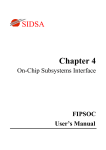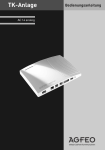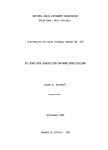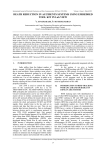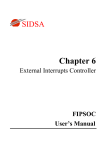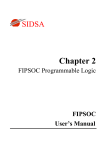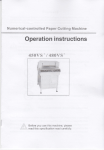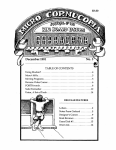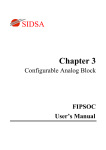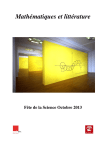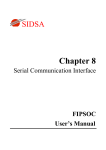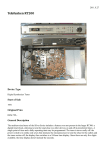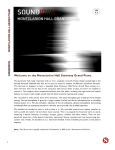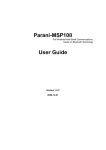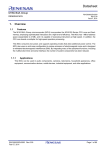Download FIPSOC User Manual
Transcript
SIDSA
Chapter 9
FIPSOC Boot Program
FIPSOC
User’s Manual
SIDSA
Semiconductor Design Solutions
FIPSOC Boot Program
Overview
The Field Programmable System On Chip (FIPSOC)
constitutes a new concept in system integration. It
provides the user with the possibility of integrating a
microprocessor core along with programmable digital
and analog cells within the same integrated circuit.
This chip can be considered as a large granularity
FPGA with a FPAA (Field Programmable Analog
Array) and a built-in microprocessor core that does
not only act as a general purpose processing element,
but also configures the programmable cells and their
interconnections. Therefore, there is a strong
interaction between hardware and software as long as
signal values and configuration data within the
programmable
cells
are
accessible
from
microprocessor programs.
This chapter describes the program stored in internal
ROM used to boot the device from a serial stream.
The program interprets in real time an extension of
Intel's HEX records. Commands are provided for
programming internal (both directly and indirectly)
and external RAM, reading internal (both directly and
indirectly) and external RAM and code ROM, and
program branching and returning. SFRs can then be
accessed this way as long as direct writes to the
internal memory can be done.
The extended HEX records are taken either from the
RS-232 serial port (typically coming from a PC) or
from a serial memory (typically flash or E2PROM)
supporting SPI or 2-wire protocols. RS-232 and SPI
modes also support reading, so the whole chip can be
controlled (programmed and read) using a single
serial link (typically from a PC).
1. Boot modes
FIPSOC provides four boot modes which are selected
from external pins boot1 and boot2. The address port
AD[15:8] is sampled during reset to provide extra
configuration information. Table 1 shows the four
boot modes.
Chapter 9. FIPSOC Boot Program
boot1
0
0
1
1
boot0
0
1
0
1
Boot mode
2-wire
SPI
SCI
External parallel ROM
Table 1: FIPSOC boot modes
The last FIPSOC boot mode can be read with the
special function register (SFR) SBCR located at
address $9D:
7
6
5
4
3
2
1
0
SCEN
SCSL
Master
SCIE
GOE
OD
IREN
BAUD
SCEN (bit 7) - Serial Communication Enable: The
serial communication system, which can be
configured either as 2-wire or SPI, is enabled if this
bit is high. Its value upon reset is the inverted value
of the external BOOT1 pin.
SCSL (bit 6) - Serial Communication Select: The
serial communication system is configured as 2-wire
if this bit is set, SPI otherwise. Its value upon reset is
the inverted value of the external BOOT0 pin.
Master (bit 5) - Boot Master: This bit stores the
serial communication mode (master or slave) upon
reset . Its value is the inverted value of bit #15 of the
address port, AD[15], and is latched during the reset
sequence.
SCIE (bit 4) - Serial Communication Interrupt
Enable: It enables the interrupt of the serial
communication system. Its reset value is zero.
GOE (bit 3) - Global Output Enable: When reset, it
disables every output of every DMC and places all
the IO pads in input state. Its reset value is zero.
OD (bit 2) - Open Drain: The general purpose port
GPORT pins behave as open drain when configured
as outputs when this bit is set, as normal CMOS
outputs otherwise. Its reset state depends on the boot
mode: if booting from SPI (BOOT1=0 and
BOOT0=1), then OD is initialized from bit #10 of the
address port, AD[10]; if booting from 2-wire
(BOOT1=BOOT0=0), OD is initialized to 1;
otherwise, OD is initialized to zero (normal CMOS
outputs), although all bits in the data direction
register DDRP are initialized to 1 thus configuring all
port pins as inputs.
2
SIDSA
IREN (bit 1) - Internal ROM Enable: When set,
the internal ROM where the boot program is located
is mapped at locations $0000 to $001FF. The reset
state of this bit is the OR function of the external
BOOT mode pins, that is, the internal boot ROM is
enabled when booting from a serial link and disabled
if booting from external parallel ROM.
Baud (bit 0) - SCI boot baud rate: This bit selects
the initial baud rate of the SCI port when booting
from it: if set, fosc/4992 is selected (3205,1 baud if a
typical 16 MHz xtal is used), fosc/1536 otherwise
(10416,6 baud if a typical 16 MHz xtal is used). Its
reset state is latched during reset from bit #8 of the
address port, AD[8].
Bits 7, 6, 4, 3, 2 and 1 keep their meaning after reset
and are use to control their corresponding specific
FIPSOC features at any time. In particular the SPI or
2-wire interface could be independently used
regardless of the boot mode.
1.1. Booting from external parallel
ROM
This mode is entered when external pins boot1 and
boot0 are both tied to 1 during the reset sequence. In
this mode the 8051 is booted from a external parallel
ROM as the 8051 standard device, starting execution
at position $0000.
1.2. Booting from a serial link
FIPSOC boots from a serial link when external pins
boot1 and boot0 are not both tied to 1 during the reset
sequence. In these three modes a boot program stored
in a 512-byte internal ROM located at address 0000H
is executed upon reset. The program is essentially the
same for the three modes except for the source the
data is fetched from, which is configured after
sampling external pins boot1 and boot0 upon reset: In
mode 10 (boot1=1 and boot0=0), data is received
from the serial port (typically from a PC); in modes
00 (boot1=0 and boot0=0) and 01 (boot1=0 and
boot0=1), data is fetched from an 2-wire or SPI
interface respectively (typically from a serial flash or
EEPROM).
Semiconductor Design Solutions
way, a zero number of bytes field is possible, and the
checksum field will closely follow the record type
field.
The checksum field is a byte such as the following
formula is satisfied:
(number_of_bytes + address_high + address_low +
record_type + { data_byte } ) mod 256 + checksum =
0
Note that the leading colon (ASCII 3AH) is not
included in the checksum calculation.
Up to nine record types are currently supported. They
are explained below:
Record type 00H: Write to external memory. The
general syntax for this record is the following:
: <number_of_bytes> <add_H> <add_L> 00H
{<byte>} <checksum>
Interpretation
of
this
command
writes
number_of_bytes bytes specified in the byte fields in
sequential memory locations of the external data
RAM memory starting from address add_H * 256 +
add_L. The number of bytes that can be written is
limited to 63, and an attempt to write more than that
will in general cause a checksum error.
Record type 08H: Read from external memory. The
general syntax for this record is the following:
:01H
<add_H><add_L>
<number_of_bytes> <checksum>
08H
Interpretation
of
this
command
reads
number_of_bytes bytes from sequential memory
locations of the external data RAM memory starting
from address add_H * 256 + add_L. Data is sent
trough the serial link sequentially as it is read. This
record is not supported if 2-wire communication
mode is selected.
Record type 0CH: Read from code memory. The
general syntax for this record is the following:
:01H
<add_H><add_L>
<number_of_bytes> <checksum>
0CH
After initialization, the boot program keeps
interpreting in real time configuration commands
similar to Intel's HEX records. The syntax of these
records is as follows:
Interpretation
of
this
command
reads
number_of_bytes bytes from sequential memory
locations of the external code (ROM) memory
starting from address add_H * 256 + add_L. Data is
sent trough the serial link sequentially as it is read.
This record is not supported if 2-wire communication
mode is selected.
:
<number_of_bytes>
<address_low>
{<data_byte>} <checksum>
Record type 10H: Indirectly write to internal
memory. The general syntax for this record is the
following:
1.2.1.
Extended HEX records
<address_high>
<record_type>
Each field in a record is a single byte, including a
leading 3AH (the ASCII code of the colon ":").
: <number_of_bytes>
{<byte>} <checksum>
The number of bytes field only refer to the data bytes
represented in brackets in the syntax above. This
Interpretation
of
this
command
writes
number_of_bytes bytes specified in the byte fields in
Chapter 9. FIPSOC Boot Program
<add_H> <add_L> 10H
3
SIDSA
Semiconductor Design Solutions
sequential memory locations of the internal data
RAM memory starting from address add_L using
indirect addressing (the add_H field is ignored but
used in the checksum). This implies that writes to
addresses ranging from 80H to FFH will be done on
data memory rather than SFRs. The number of bytes
that can be written is limited to 63, and an attempt to
write more than that will in general cause a checksum
error.
Record type 18H: Indirectly Read from internal
memory. The general syntax for this record is the
following:
:01H
<add_H><add_L>
<number_of_bytes> <checksum>
18H
Interpretation
of
this
command
reads
number_of_bytes bytes from sequential memory
locations of the internal data RAM memory starting
from address add_L using indirect addressing (the
add_H field is ignored but used in the checksum).
This implies that reads from addresses ranging from
80H to FFH will be done on data memory rather than
SFRs. Data is sent trough the serial link sequentially
as it is read. This record is not supported if 2-wire
communication mode is selected.
Record type 20H: Directly write to internal memory.
The general syntax for this record is the following:
: <number_of_bytes>
{<byte>} <checksum>
<add_H> <add_L> 20H
Interpretation
of
this
command
writes
number_of_bytes bytes specified in the byte fields in
sequential memory locations of the internal data
RAM memory starting from address add_L using
direct addressing (the add_H field is ignored but used
in the checksum). This implies that writes to
addresses ranging from 80H to FFH will be done on
SFRs rather than data memory. The number of bytes
that can be written is limited to 63, and an attempt to
write more than that will in general cause a checksum
error.
Record type 40H: Jump to address. The general
syntax for this record is the following:
:00H <add_H><add_L> 40H <checksum>
Interpretation of this command produces a direct
jump to address add_H * 256 + add_L. Depending on
the booting mode, parts of the serial link circuitry
may be powered down prior to jumping.
Record type 48H: Return from subroutine. The
general syntax for this record is the following:
:00H <add_H><add_L> 48H <checksum>
Interpretation of this command executes a "RET"
instruction, which pops the address to jump to from
the stack. It is used when the record parsing program
is used as a subroutine from an user application
program. fields add_H and add_L are ignored but
used in the checksum.
1.2.2.
Extended record types and errors
Record types 80H to FFH are available for command
set extension. If such a record type is parsed the
program jumps to address $FF2B where an
appropriate parsing routine should be found. Upon
initialization a default error routine is written there.
This error routine is entered whenever a colon is not
found at the begining of an HEX record, a checksum
is incorrect, a record type is not recognized or any
other parsing problem is detected. This routine resets
the GOE bit to place the whole programmable logic
are in an idle mode and then keeps branching to the
same address.
1.2.3.
Booting from SPI
When boot1 is 0 and boot0 is 1 during the reset
sequence, the extended HEX records are fetched from
the SPI serial link. The address port AD is also
sampled upon reset and automatically configures
several features of the SPI interface according to
external user-defined hardware settings:
7
6
5
4
3
2
Master
CPOL
CPHA
CK1
CK0
OD
1
0
Record type 28H: Directly Read from internal
memory. The general syntax for this record is the
following:
Master (bit 7): FIPSOC will act as an SPI master if
this bit is set, slave otherwise.
:01H
<add_H><add_L>
<number_of_bytes> <checksum>
28H
CPOL (bit 6): Selects the SPI clock polarity (refer to
the SPI section of this user's manual).
Interpretation
of
this
command
reads
number_of_bytes bytes from sequential memory
locations of the internal data RAM memory starting
from address add_L using direct addressing (the
add_H field is ignored but used in the checksum).
This implies that reads from addresses ranging from
80H to FFH will be done on SFRs rather than data
memory. Data is sent trough the serial link
sequentially as it is read. This record is not supported
if 2-wire communication mode is selected.
CPHA (bit 5): Selects the SPI clock phase (refer to
the SPI section of this user's manual).
Chapter 9. FIPSOC Boot Program
CK1 and CK0 (bits 4 and 3): Select the SPI clock
frequency as shown in table 2 (refer to the SPI
section of this user's manual).
4
SIDSA
CK1
CK2
0
0
1
1
0
1
0
1
SPI clock
frequency
fosc/8
fosc/16
fosc/32
fosc/64
Semiconductor Design Solutions
Bits 6-0: These bits set the 7-bit logical device
address. The four most significant ones are said to be
the major device address which is only dependent on
the nature of the device itself. The three least
significant ones are the minor device address and are
the ones that change among instances of the same
device.
frequency for
fosc=16MHz
2 MHz
1 MHz
500 KHz
250 KHz
Table 2: SPI clock frequencies upon reset
OD (bit 2): Bit lines will be open-drain if OD is set
to 1, normal CMOS outputs otherwise.
Bit 0 also configures the clock rate upon reset (refer
to the 2-wire section of this user's manual).
GPORT[0]
Bits1 and 0: not sampled upon reset.
If configured as master, the initialization sequence
goes as follows:
step 1: bit 0 of the general purpose register is driven
low (and the corresponding bit of the data direction
register is set to "output") to select a slave through
the slave select line, typically the serial memory.
step 2: Command 03H is sent through the line, which
is interpreted by a serial SPI memory as a "read"
command.
step 3: Two zero bytes are sent through the line,
which is interpreted by a serial SPI memory as a the
initial memory location to start reading from.
step 4: A dummy FFH byte is sent through the line,
which provokes the first real data byte to be obtained
from the serial memory.
After initialization, the boot program keeps reading
the incoming bytes and interpreting extended HEX
records as the are completed. Once a byte has been
received, the same byte is echoed back through the
line to trigger the next read in the memory.
When a JUMP instruction is found (record type 40H),
bit 0 of the general purpose port is released and
configured again as input, and the SPI
communications system is switched off before
actually executing the jump.
If configured as a slave the program does the same
except for that no initialization is performed other
than placing an initial FFH in the outgoing shift
register. Bytes are echoed back as they arrive, which
can be checked out by the master to validate
transfers.
1.2.4.
Booting from 2-wire
When boot1 and boot0 are both 0 during the reset
sequence, the extended HEX records are fetched from
the 2-wire serial link. The general purpose port
GPORT is also sampled upon reset and automatically
configures several features of the 2-wire interface
according to external user-defined hardware settings:
7
Master
6
5
4
3
Major device address
2
1
0
Minor device address
Master (bit 7): FIPSOC will act as an 2-wire master
if this bit is set, slave otherwise.
Chapter 9. FIPSOC Boot Program
0
1
2-wire clock
frequency
fosc/16
fosc/160
frequency for
fosc=16MHz
1 MHz
100 KHz
Table 3: 2-wire clock frequencies upon reset
If configured as master, the initialization sequence
goes as follows:
step 1: The device waits until the 2-wire line is free,
and then it sends a START command to grab the line.
step 2: Once the line has been taken, a WRITE
command is sent to a device with address 1010000. If
no acknowldege is received, then FIPSOC sends a
RESTART command without releasing the line and
sends a WRITE command to the next device address,
1010001. It keeps restarting and trying until a device
answers.
step 3: Once a device answers by acknowledging the
ninth bit, two consecutive zeroes are sent to the line
to specify the address to start reading from.
step 4: If no error is detected (otherwise a STOP
command is issued and the program goes back to step
1), a RESTART command is issued and a READ
command is sent to the device address that answered
before.
step 5: A dummy FFH byte is sent through the line,
which provokes the first real data byte to be obtained
from the serial memory.
After initialization, the boot program keeps reading
the incoming bytes and interpreting extended HEX
records as the are completed. Once a byte has been
received, the same byte is echoed back through the
line to trigger the next read in the memory.
When a JUMP instruction is found (record type 40H),
a STOP command is issued, and the 2-wire
communications system is switched off before
actually executing the jump. When a RETURN
instruction is found (record type 48H), only the
STOP command is issued before returning.
If configured as a slave, the program waits to be
addressed (a WRITE command is received with the
appropriate device address) and then sends a dummy
FFH to acknowledge the reception. After that, the
program keeps receiving bytes through the 2-wire
line and interpreting extended HEX records as they
5
SIDSA
are completed. When a JUMP instruction is found
(record type 40H), the 2-wire communications
system is switched off before actually executing the
jump.
It is important to note that record types 08H, 0CH,
18H and 28H (used for memory reading) are not
supported in 2-wire boot modes. A program
extension has to be loaded somewhere else (for
example in the auxiliary upper RAM located in
$FF00 to $FFFF) to extend the supported record type
set.
1.2.5.
Booting from SCI
When boot1 is 1 and boot0 is 0 during the reset
sequence, the extended HEX records are fetched from
the RS232 serial port. Bit #8 of the address port
(AD[8]) is latched upon reset into the BAUD bit of
the BTREG register and is used to determine the
initial baud rate of the incoming bytes: if set,
fosc/4992 is selected (3205,1 baud if a typical 16 MHz
xtal is used), fosc/1536 otherwise (10416,6 baud if a
typical 16 MHz xtal is used).
After initialization, the boot program keeps reading
the incoming bytes from the serial line and
interpreting extended HEX records as the are
completed. Once a byte has been received, the same
byte is echoed back through the line.
1.3. The internal boot ROM and the
auxiliary upper RAM
When booting from a serial link is selected, the
internal boot ROM which stores the boot program
that configures the serial link and parses the extended
HEX records is enabled. It is mapped at locations
$0000 to $01FF and, if enabled, overwrites any other
Chapter 9. FIPSOC Boot Program
Semiconductor Design Solutions
program memory that could mapped at these
locations.
In these modes the auxiliary 256-bytes RAM block
mapped at addresses $FF00 to $FFFF is also enabled
(bit #1 in RG2 set to one). Locations $FFFD through
$FFFF of this RAM block are modified by the direct
read and write commands over the internal memory.
These commands are especially provided to
dynamically read and write SFRs, and use selfmodifying code to do direct accesses rather than
indirect ones.
The normal interrupt vectors, located at addresses
$0003, $000B and so on, are also stored in ROM and
permanently point to the upper auxiliary RAM to
locations $FF03, $FF0B and so on. No initialization
is performed to these RAM locations.
Address $FF2B is used for HEX command extension.
The program branches to this address when a record
type between 80H and FFH is parsed. This address is
initialized with a jump to an error routine in case an
extended record arrives before the extension code is
downloaded. This error routine is entered whenever a
colon is not found at the begining of an HEX record,
a checksum is incorrect, a record type is not
recognized or any other parsing problem is detected.
This routine resets the GOE bit to place the whole
programmable logic are in an idle mode and then
keeps branching to the same address.
2. Boot program listing
We provide here a complete assemble listing of the
boot program.
6
SIDSA
Semiconductor Design Solutions
**********************************************
**********************************************
**********
FIPSOC boot program ************
**********
************
**********
By Julio Faura and
************
**********
Ignacio Lacadena
************
**********
************
**********
(C) SIDSA 1998
************
**********************************************
**********************************************
*****************************************************************
*************** FIPSOC SFRs symbol definition *****************
*****************************************************************
; ********** SFRs in the standard 8051 ***********
SP
DPL
DPH
PCON
TCON
TMOD
TL0
TL1
TH0
TH1
SCON
SBUF
IE
IP
PSW
EQU
EQU
EQU
EQU
EQU
EQU
EQU
EQU
EQU
EQU
EQU
EQU
EQU
EQU
EQU
081H
082H
083H
087H
088H
089H
08AH
08BH
08CH
08DH
098H
099H
0A8H
0B8H
0D0H
* Definitions for bit addressing:
RI
TI
RB8
TB8
REN
SM2
SM1
SM0
EQU
EQU
EQU
EQU
EQU
EQU
EQU
EQU
098H
099H
09AH
09BH
09CH
09DH
09EH
09FH
;Receiver interrupt flag
;Transmitter interrupt flag
;9th bit (received)
;9th bit (sent)
;Reception Enable
;SM<2:0> == Mode specifier
; ***************** Internal ports definitions ********************
PORT0
PORT1
PORT2
PORT3
EQU
EQU
EQU
EQU
80H
90H
0A0H
0B0H
* Definitions for bit addressing:
RXD
EQU 0B0H
; USART Receiver
TXD
EQU 0B1H
; USART Transmitter
NINT0
EQU 0B2H
; External interrupt input 0, active low
NINT1
T0
T1
NWR
NRD
EQU
EQU
EQU
EQU
EQU
;
;
;
;
;
;
;
;
;
;
;
;
0B3H
0B4H
0B5H
0B6H
0B7H
External interrupt input 1, active low
Timer 0 external input
Timer 1 external input
External data memory write strobe, active low.
External data memory read strobe, active low.
*************** FIPSOC specific SFRs definitions ******************
The following registers are *not* present in the standard 8051.
Therefore, some (most) macro assemblers and compilers may not
admit them as they are not legal direct memory locations (special
function registers) in the standard device. To avoid this problem
they should be assembled as an external module and exported with
Chapter 9. FIPSOC Boot Program
7
SIDSA
;
;
;
;
;
;
Semiconductor Design Solutions
GLOBAL clauses, while they should be imported with EXTERNAL clauses
from the main module. This normally suffice to trick the assembler
into believing that these symbols will be placed in (legal) direct
memory locations (lower than 7FH), although the linker could object
if it notices the final memory locations (which is not usual as the
linker does not use to perform any consistency check).
WDOG
RG3
SCREG
I2CREG
SPIREG
BTREG
DDRP
CMBUF
EQU
EQU
EQU
EQU
EQU
EQU
EQU
EQU
9AH
9BH
9CH
9CH
9CH
9DH
9EH
9FH
VPLLL
VPLLH
VHW1L
VHW1H
EQU
EQU
EQU
EQU
0A4H
0A5H
0A6H
0A7H
VCLKL
VCLKH
VHW2L
VHW2H
EQU
EQU
EQU
EQU
0ACH
0ADH
0AEH
0AFH
VDBGL
VDBGH
VHW3L
VHW3H
EQU
EQU
EQU
EQU
0B4H
0B5H
0B6H
0B7H
VHW4L
VHW4H
VANAL
VANAH
EQU
EQU
EQU
EQU
0BCH
0BDH
0BEH
0BFH
EIMR0
EIMR1
SGNI0
SGNI1
IRS
IRSCKDB
EQU
EQU
EQU
EQU
EQU
EQU
0C0H
0C1H
0C2H
0C3H
0C4H
0C5H
DANA1
DANA2
DANA3
DANA4
DANA5
DANA6
DANA7
DANA8
EQU
EQU
EQU
EQU
EQU
EQU
EQU
EQU
0D8H
0D9H
0DAH
0DBH
0DCH
0DDH
0DEH
0DFH
ANAST
DBGCNF
DBGMSK
DBG0L
DBG0H
DBG1L
DBG1H
EQU
EQU
EQU
EQU
EQU
EQU
EQU
0E1H
0E2H
0E3H
0E4H
0E5H
0E6H
0E7H
DBG2L
DBG2H
DBG3L
DBG3H
DBG4L
DBG4H
DBG5L
DBG5H
EQU
EQU
EQU
EQU
EQU
EQU
EQU
EQU
0E8H
0E9H
0EAH
0EBH
0ECH
0EDH
0EEH
0EFH
CKCONF
CKCNTL
CKCNTH
CKDMC2
CKDMC1
CKANA
CK8051
EQU
EQU
EQU
EQU
EQU
EQU
EQU
0F1H
0F2H
0F3H
0F4H
0F5H
0F6H
0F7H
Chapter 9. FIPSOC Boot Program
8
SIDSA
ROWL
ROWH
COLL
COLH
RG1
RG2
RGTX
outCOMP
EQU
EQU
EQU
EQU
EQU
EQU
EQU
EQU
Semiconductor Design Solutions
0F8H
0F9H
0FAH
0FBH
0FCH
0FDH
0FEH
0FFH
PAGE
TITLE "boot.asm"
;Constants for bit-addressing the accumulator:
BOOT1
EQU 7
;These three flags store the boot mode
BOOT0
EQU 6
;
MASTER
EQU 5
;
BAUD
EQU 0
;Baud rate when booting from SCI
;Constants for bit-addressing the accumulator:
CCF
EQU 7
;Comunicación complete flag
I2CMAST EQU 6
;Sets to one when we are master
SDRC
EQU 5
;1=Send, 0=receive
CK0
EQU 4
;1=100KHz, 0=1MHz
ID
EQU 3
;To see if we have been addressed (slave)
ERR
EQU 2
;Sets to one when we don't get an acknowledge
CMD
EQU 1
;Write this bit to send commands
BBUSY
EQU 0
;Bus Busy (also used to send commands)
**********************************************
DATA
ORG 7BH
;This is located here so the data buffer starts on 80H
COLON
LENGTH
ADD_H
ADD_L
REC_T
DS
DS
DS
DS
DS
;Dummy buffer to store the frame start (a colon)
;Number of bytes in DATABUF
;Address high byte
;Address low byte
;00 == Write to external mem
;08H == Read from external (data) mem
;0CH == Read from external program mem
;10H == Indirectly write to internal mem
;18H == Indirectly read from internal mem
;20H == Directly write to internal mem
;28H == Directly read from internal mem
;40H == Jump to address (LJMP)
;48H == Return (ends with RET instead of LJMP)
;Codes 80H to FFH are used for command set extension
DATABUF
DS 40H
;Data buffer + checksum
STACK
DS 1
;Where the stack pointer should initially point to
SFMDCOD
EQU FFFDH
EXT_CMD
EQU FF2BH
;This is the self modifying code location
;for SFR indirect access.
;Code for extending the HEX command set
1
1
1
1
1
COLONVAL EQU ':'
FIRSTDEV EQU A1H
;Constant value for the colon character
;The first I2C device to be probed
Chapter 9. FIPSOC Boot Program
9
SIDSA
Semiconductor Design Solutions
*******************************************************
CODE
; Interrupt pseudovectors pointing to upper RAM
; Linked to INIT program (this is quite tricky!!)
ORG 00H
RESET
MOV R3,A
SJMP INIT
;This clears R3 for the first TXBYTE
VEC_IE0
INIT
LJMP FF03H
MOV SP,#STACK
SJMP INIT1
;This should be $03
VEC_TF0
INIT1
LJMP FF0BH
MOV DPTR,#EXT_CMD
SJMP INIT2
;This should be $0B
VEC_IE1
INIT2
LJMP FF13H
MOV A,#02H
SJMP INIT3
nop
;This should be $13
;Op-code for LJMP
LJMP FF1BH
MOV RG2,A
MOVX @DPTR,A
SJMP INIT4
;This should be $1B
;Maps the aux RAM memory for program and data
VEC_TF1
INIT3
VEC_RITI LJMP FF23H
;Empty byte
;This should be $23
*******************************************************
; Off we go
*******************************************************
INIT4
INC DPTR
MOV A,#ERROR/100H
MOVX @DPTR,A
INC DPTR
MOV A,#ERROR-(ERROR/100H)*100H
MOVX @DPTR,A
MOV A,SCREG
;Strongly recommended ;)
MOV A,BTREG
;Select the subsystem to initialize
JNB A.BOOT1,INIT_SCI ;If boot1==0 then we are booting from SCI
JNB A.BOOT0,INIT_SPI ;If boot0==0 then we are booting from SPI
JB A.MASTER,INIT_I2C ;If we are I2C master
********************************************
; I2C configuration as slave
********************************************
INI2C_SL MOV A,SCREG
;Wait for BBUSY == ID == 1
ANL A,#9
CJNE A,#9,INI2C_SL
ACALL TXBYTE
MOV A,R5
CJNE A,#89,INI2C_SL
MOV CMBUF,#FFH
;This is the acknowledge
SJMP GET_FRAM
Chapter 9. FIPSOC Boot Program
10
SIDSA
Semiconductor Design Solutions
********************************************
; Send an STOP command and start again
********************************************
STOPNGO ACALL I2CSTOP
;Uncomment the following if the next label is not INIT_I2C
;
SJMP INIT_I2C
********************************************
; I2C configuration as master
********************************************
INIT_I2C MOV A,SCREG
JB A.BBUSY,W4BUSFRE
ACALL START
MOV R3,#FIRSTDEV
;We probe the first device
I2CLOOP ACALL TXBYTE
JNB A.CCF,INIT_I2C
JNB A.ERR,I2CFOUND
INC R3
;Next device
INC R3
ACALL RESTART
SJMP I2CLOOP
I2CFOUND MOV A,R3
;R3 has now the device that answered
ANL A,#FEH
;We prepare for a READ command
MOV R3,A
MOV CMBUF,#0
;We send two zeroes as a 16-bit address
ACALL WAIT4IT
CJNE R5,#C9H,STOPNGO
MOV CMBUF,#0
ACALL WAIT4IT
CJNE R5,#C9H,STOPNGO
ACALL RESTART
ACALL TXBYTE
;We left the device address in R3
CJNE R5,#C9H,STOPNGO
SJMP GO_ON
********************************************
; RS232 Serial interface configuration
********************************************
INIT_SCI MOV SCON,#50H
;Mode 010, REN enable, clear flags
MOV PCON,#80H
;Double baud rate, clear flags
MOV TCON,#40H
;Start the Timer #1
MOV TMOD,#20H
;Sets timer #1 in 8-bits reload mode
MOV TH1,#F3H
;243 for 3205 baud (with a 16 MHz xtal)
JB A.BAUD,GET_FRAM ;3205 baud if GPORT.0 is 1, 10416 baud otherwise
MOV TH1,#FCH
;252 for 10416 baud (with a 16 MHz xtal)
SJMP GET_FRAM
********************************************
; SPI configuration
********************************************
INIT_SPI ANL SCREG,#F3H
;Clears dummy flags
JNB A.MASTER,GO_ON ;No more initialization required if slave
MOV PORT1,#FEH
;Select First SPI device
MOV DDRP,#FEH
;Bit 0 of general port as output
MOV R3,#3
ACALL TXBYTE
MOV R3,#0
ACALL TXBYTE
ACALL TXBYTE
;Uncomment the following if the next label is not GO_ON
;
SJMP GO_ON
GO_ON
MOV CMBUF,#FFH
********************************************
; Main loop for frame fetching and parsing
********************************************
GET_FRAM MOV R0,#COLON
;This is the main loop (fetching records)
ACALL GET_BYTE
JNZ ERROR
MOV A,R3
Chapter 9. FIPSOC Boot Program
11
SIDSA
Semiconductor Design Solutions
MOV @R0,A
CJNE @R0,#COLONVAL,ERROR ; Check if the colon was OK
INC R0
ACALL GET_BYTE
JNZ ERROR
MOV A,R3
ANL A,#3FH
;We limit the number of bytes to 3F
MOV @R0,A
ADD A,#4
MOV R2,A
GF_LOOP
CHKSUM
CHKLOOP
INC R0
ACALL GET_BYTE
JNZ ERROR
MOV A,R3
MOV @R0,A
DJNZ R2,GF_LOOP
MOV R0,#LENGTH
MOV A,#4
ADD A,@R0
MOV R2,A
MOV A,@R0
INC R0
ADD A,@R0
DJNZ R2,CHKLOOP
JNZ ERROR
MOV
MOV
MOV
MOV
MOV
MOV
DPH,ADD_H
DPL,ADD_L
R0,#DATABUF
R1,ADD_L
R2,LENGTH
R4,REC_T
;Get a byte and bring it in A
;Total number of bytes = length + 4
;R2 is used as a (down) counter
;Sum of al bytes + checksum = 0
;This is going to be used in the three commands
MOV A,R4
GOON1
;
GOON2
GOON3
CJNE A,#40H,GOON1
ACALL ENDCOMS
CLR A
JMP @A+DPTR
CJNE A,#48H,GOON2
ACALL ENDCOMS
RET
JNB A.7,GOON3
LJMP EXT_CMD
;Jump if REC_T == 40H
;Return if REC_T == 48H
;Do not stop if this is a subroutine!
;REC_T >= 80H -> Extended command (in $FF2B)
JNB A.3,GOON4
ACALL READMEM
JNZ ERROR
SJMP GET_FRAM
GOON4
ACALL PROGMEM
JZ GET_FRAM
; Uncomment the following if the next label is not ERROR
;
SJMP ERROR
ERROR
ANL BTREG,#F7H
SJMP ERROR
;We reset GOE!!
********************************************
; End communications
********************************************
ENDCOMS MOV A,BTREG
JNB A.BOOT1,ENDSCI ;If SCI, wait for TI, clear it and bail out
JNB A.BOOT0,ENDSL ;IF SPI, just switch the system off and bail out
JNB A.MASTER,ENDSL ;Otherwise, it's I2C
ACALL I2CSTOP
;If we're master, then stop the communication
ENDSL
MOV PORT1,#FFH
MOV DDRP,#FFH
ANL BTREG,#7FH
RET
ENDSCI
JNB TI,ENDSCI
;Otherwise, switch off the coms system
Chapter 9. FIPSOC Boot Program
12
SIDSA
Semiconductor Design Solutions
CLR TI
RET
********************************************************
;
; Routine: PROGMEM
;
; Inputs: DPTR is ADD_H,ADD_L
;
R0 points to the first data byte in the buffer
;
R1 is ADD_L
;
R2 has the number of bytes to write
;
R4 is the record type
; Outputs: A == 0 if no error, FF otherwise
;
; Modifies: A, R0, R1, R2, DPTR
;
; Programs any kind of memory
;
********************************************************
PROGMEM
CJNE R2,#0,PROGLOOP
RET
PROGLOOP MOV A,@R0
CJNE R4,#00H,PROG1 ;Program external memory
MOVX @DPTR,A
SJMP GOPROG
PROG1
CJNE R4,#10H,PROG2 ;Indirectly program internal memory
MOV @R1,A
SJMP GOPROG
PROG2
CJNE R4,#20H,RETERR;Directly program internal memory
MOV DPTR,#SFMDCOD ;This is the self-modifying code location
MOV A,#86H
;Hex code for "MOV direct,@R0"
MOVX @DPTR,A
INC DPTR
MOV A,R1
MOVX @DPTR,A
;Modify the code with the direct address
INC DPTR
MOV A,#22H
;Hex code for "RET"
MOVX @DPTR,A
LCALL SFMDCOD
GOPROG
INC DPTR
INC R0
INC R1
DJNZ R2,PROGLOOP
CLR A
RET
;No error occurred
********************************************************
;
; Routine: READMEM
;
; Inputs: DPTR is ADD_H,ADD_L
;
R0 points to the number of bytes to read
;
R1 is ADD_L
;
R2 has the number of bytes to write
;
R4 is the record type
; Outputs: A == 0 if no error, FF otherwise
;
; Modifies: A, R0, R1, R3, DPTR
;
; Reads any kind of memory
;
********************************************************
READMEM
MOV R2,@R0
;R0 equals #DATABUF
CLR A
CJNE R2,#0,READLOOP
RET
READLOOP XCH A,R3
CJNE R4,#08H,READ1 ;Read external memory
MOVX A,@DPTR
SJMP GOREAD
Chapter 9. FIPSOC Boot Program
13
SIDSA
READ1
READ2
READ3
Semiconductor Design Solutions
CJNE R4,#0CH,READ2 ;Read code
CLR A
MOVC A,@A+DPTR
SJMP GOREAD
CJNE R4,#18H,READ3 ;Indirectly read internal memory
MOV A,@R1
SJMP GOREAD
CJNE R4,#28H,RETERR ;Directly read internal memory
MOV DPTR,#SFMDCOD
MOV A,#E5H
;Hex code for "MOV A,direct"
MOVX @DPTR,A
INC DPTR
MOV A,R1
MOVX @DPTR,A
INC DPTR
MOV A,#22H
;Hex code for "RET"
MOVX @DPTR,A
LCALL SFMDCOD
;Now the data is in A
GOREAD
;
;
;
;
XCH A,R3
ADD A,R3
PUSH A
;We save the sum
ACALL SENDBYTE
;We send R3
JNZ RETERR
POP A
;We restore the sum
INC DPTR
INC R1
DJNZ R2,READLOOP
Now A has the sum and we must calculate and send the checksum
CPL A
;Calculate checksum
INC A
;'twas 2's complement
MOV R3,A
Uncomment the following if the next routine is not SENDBYTE
ACALL SENDBYTE
;Send checksum
RET
********************************************************
;
; Routine: SENDBYTE
;
; Inputs: R3 is the byte to send
; Outputs: A == 0 if no error, FF otherwise
;
; Modifies: A, R5
;
; Sends a byte no matter where thru. It waits for a previous
; transmission to be completed:
;
- If SCI is used, then it waits for a serial byte to come
;
prior to send R3.
;
- If SPI is used, then it waits for SPIF to be up. If we
;
are slave, they should provoke a (dummy) transmission
;
before we send R3; if we are master, we should provoke
;
a dummy transmission before calling SENDBYTE. This is
;
normally used for sending a group of bytes, so each
;
transmission is used to trigger the following. Obviously
;
the first transmission has to be provoked manually.
;
********************************************************
SENDBYTE MOV
JNB
JNB
MOV
RET
A,BTREG
A.BOOT1,SB_SCI
A.BOOT0,SB_SPI
A,#FFH
;I2C reads not supported
SB_SPI
ACALL WAIT4IT
CJNE A,#80H,RETERR
MOV CMBUF,R3
CLR A
RET
;We wait for the previous transmission to end
;Maybe we shouldn't check this out
;We send R3
;No error occurred
SB_SCI
JNB
CLR
CLR
MOV
;We wait for the previous transmission to end
;We assume nothing is left
RI,SB_SCI
RI
TI
SBUF,R3
;We send R3
Chapter 9. FIPSOC Boot Program
14
SIDSA
CLR A
RET
Semiconductor Design Solutions
;No error occurred
********************************************
; Return with A == FF (error)
********************************************
RETERR
MOV A,#FFH
RET
********************************************************
;
; Routine: GET_BYTE
;
; Inputs: None
; Outputs: A stores bits CCF and ERR
;
R3 stores the recevied byte
;
R5 stores SCREG but bits SDRC and CK0
;
; Modifies: A, R3, R5 (WAIT4IT is called afterwards)
;
; Gets a byte no matter where from and echoes it afterwards
;
********************************************************
GET_BYTE MOV A,BTREG
;Get a byte no matter where from, result in R3
JNB A.BOOT1,GB_SCI
GB_SCOM
ACALL WAIT4IT
;Get a byte from I2C or SPI, master or slave
CJNE A,#80H,RETERR
MOV R3,CMBUF
MOV CMBUF,R3
CLR A
;No error
RET
GB_SCI
JNB
CLR
MOV
CLR
MOV
CLR
RET
RI,GB_SCI
RI
R3,SBUF
TI
SBUF,R3
A
;Get a byte from the serial port
;Echo the received byte
;No error
********************************************************
;
; Routine: TXBYTE
;
; Inputs: R3 is the byte to send
; Outputs: A stores bits CCF and ERR
;
R5 stores SCREG but bits SDRC and CK0
;
; Modifies: A, R5 (WAIT4IT is called afterwards)
;
; Transmits a byte trough the I2C or SPI line and waits until
; transmission is finished
;
********************************************************
TXBYTE
MOV CMBUF,R3
;Send a serial byte (stored in R3)
; Uncomment the following if the next routine is not WAIT4IT
;
ACALL
WAIT4IT
;
RET
********************************************************
;
Chapter 9. FIPSOC Boot Program
15
SIDSA
Semiconductor Design Solutions
; Routine: WAIT4IT
;
; Inputs: None
; Outputs: A stores bits CCF and ERR
;
R5 stores SCREG but bits SDRC and CK0
;
; Modifies: A, R5
;
; Waits for a transmission to be completed (CCF or ERR)
;
********************************************************
WAIT4IT
MOV A,SCREG
ANL A,#CFH
MOV R5,A
ANL A,#84H
JZ WAIT4IT
RET
;Wait
;Bits
;Save
;Wait
for a serial byte to be transmitted
5 and 4 are not interesting
SCREG in R5
for CCF or ERR
********************************************************
;
; Routine: I2CSTOP
;
; Inputs: None
; Outputs: None
;
; Modifies: A and R2 (calls SENDCMD)
;
; Sends a STOP command to the I2C interface (using SENDCMD)
;
********************************************************
I2CSTOP
MOV R2,#2
ACALL SENDCMD
RET
********************************************************
;
; Routine: START, RESTART
;
; Inputs: None
; Outputs: None
;
; Modifies: A, R2 (calls SENDCMD)
;
; Sends a START command to the I2C interface (using SENDCMD)
;
********************************************************
START
RESTART MOV R2,#3
; Uncomment the following if the next routine is not SENDCMD
;
ACALL SENDCMD
;
RET
********************************************************
;
; Routine: SENDCMD
;
; Inputs: R2 is used to specify the command
;
use XXXX_XX11b for START and RESTART
;
use XXXX_XX10b for STOP
; Outputs: None
;
; Modifies: A, R2
;
; Used for sending a STOP, START or RESTART command to the
; I2C interface
;
********************************************************
SENDCMD
MOV A,SCREG
Chapter 9. FIPSOC Boot Program
16
SIDSA
CMDLOOP
Semiconductor Design Solutions
ANL A,#FCH
ORL A,R2
MOV SCREG,A
MOV A,SCREG
JB A.CMD,CMDLOOP
RET
end
Chapter 9. FIPSOC Boot Program
17

















